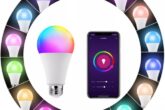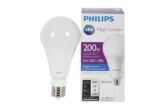Last updated on August 18th, 2024 at 05:40 am
Understanding LED light specifications will help you choose a suitable LED lamp for any application.
Remember, there are thousands of LED lighting systems today. Without the right information, you may not know the specifications of LED lighting products to look for.
Here is a quick guide to the specification of LED lighting products:
LED Color
We use peak wavelength to determine the LED color. The type of materials in the LED light determine the color. For instance, let’s take a quick look at the table below to get an overview of LED light colors:
| LED Light Color | Wavelength (nm) | Type of Material |
| Blue | 450-500 | InGaN, SiC |
| Green | 500-570 | GaP, AlGaInP, AlGaP |
| Red | 610-760 | AlGaAs, GaAsP, AlGaInP, Gap |
| Yellow | 570-590 | GaAsP, AlGaInP, Gap |
LED Light Intensity
This is another vital LED light specification you must consider. Some of the key factors determining light intensity include:
- Type of LED chip
- Current level
- LED encapsulation
- Quality of material, etc.
You can always check the LED product information to get clear information on the chip type, current level, etc.
LED Light Brightness
You should consider LED light lumen. We use lumen to determine the level of LED light brightness.
Of course, you should evaluate the total and delivered lumen for the LED light.
Additionally, you should know the lumen maintenance which is either LM-80 or L70.
LED Light Wattage
Watt determines the amount of energy the LED light uses.
Although high wattage will always imply brighter LED light, sometime this may not be the case. An LED light using less efficient material may use more energy, however, it may not be bright.
LED Light Power Factor
It determines how effectively an LED lighting system uses electricity. When the real power is high, both the utility company and the user benefit.
In most cases, manufacturers will specify LED as having a power factor of 0.90 or higher. Generally, the power factor will:
- Reduce power loses
- Improved efficiency
- Current carrying capacity
LED Light Efficacy
This is how well your LED produces visible light. You can determine this by calculating the amount of lumen for every watt the LED lighting system uses.
Currently, LED lights are popular choice due to their high efficiency.
Voltage And Current for LED Light Specification
When you increase the input current, the light output will also increase. However, you must not exceed the maximum current for LED light.
A high current may cause LED light chip to overheat, which will eventually cause damage. You should check the manufacturer’s specifications. Of course, the level of voltage drop will depend on the current.
Corrected Color Temperature (CCT)
You measure this in Kelvin. The LED light Kelvin number determines whether you have cooler light or crisper light.
A Lower Kelvin number implies warmer LED light. On the other hand, for cool and blue light, you will choose a higher Kelvin number.
Color Rendering Index (CRI)
The LED light system can show real color when you compare it to natural light. Generally, we can summarize LED Light specifications in the following main categories:
a) Bulb Specifications
You should specify if the LED lighting system is dimmable, the intended use (outdoor or indoor), the shape of the bulb, socket type, type of glass if any, and additional technology.
b) Light Characteristics
Among the key variable, you should consider include color consistency, beam angle, color rendering index, color temperature, warm-up time, light color, and nominal luminous flux.
c) Power Consumption Specifications For LED Light
You should consider the following key variables – power factor, wattage, voltage, and wattage equivalent.
In addition to these, you may also want to know the lifespan, number of switch cycles, rated power, luminous index, quality testing/certification, and efficiency.
In a nutshell, with all these specifications for LED lights, you can choose a lighting system for your specific requirements.

We would also like to hear from you – is there any LED light specifications you need any clarifications about? You can add the comments below.
Further Reading:

